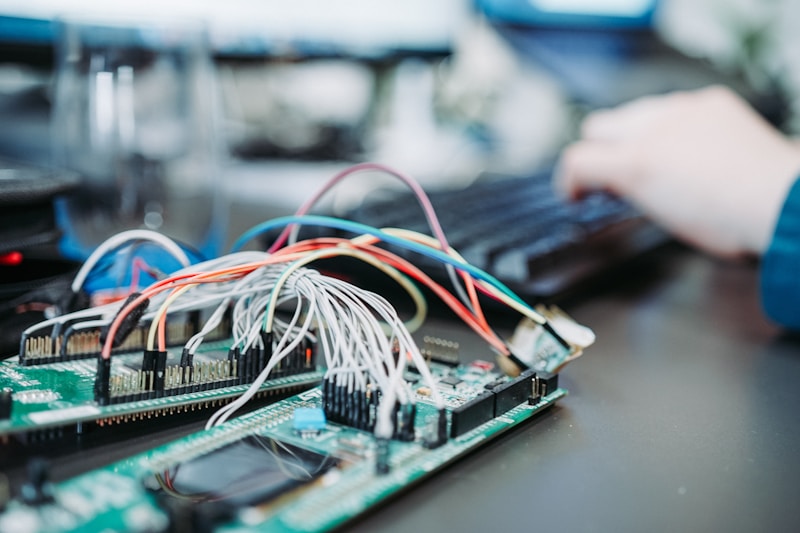Edge AI: Bringing Intelligence to IoT Devices
The convergence of artificial intelligence and Internet of Things (IoT) technology is creating a paradigm shift in how we process and analyze data. As IoT deployments scale to billions of connected devices, the traditional cloud-centric model faces mounting challenges in bandwidth, latency, reliability, and privacy. Enter Edge AI—the deployment of AI algorithms directly on IoT devices or local edge servers—bringing computation closer to data sources and enabling real-time, autonomous decision-making where it matters most.
The Evolution from Cloud to Edge: Why Edge AI Matters
Edge AI represents a fundamental shift in computational architecture that addresses several critical limitations of cloud-dependent IoT systems:
| Challenge | Cloud-Only AI | Edge AI Solution | Impact |
|---|---|---|---|
| Latency | 100-500ms round-trip for cloud processing | <10ms for local processing | 50x faster response for time-critical applications |
| Bandwidth | Raw data transmission to cloud | Only relevant insights transmitted | 95% reduction in data transmission volumes |
| Privacy | Sensitive data leaves local environment | Data processed locally, insights shared | Enhanced compliance with GDPR, HIPAA, etc. |
| Reliability | Dependent on network connectivity | Functions offline or with intermittent connectivity | Continuous operation in remote or harsh environments |
| Power Efficiency | High energy consumption for data transmission | Optimized local processing | Up to 70% reduction in power consumption |
Recent market research from Gartner indicates that by 2025, more than 75% of enterprise-generated data will be processed outside traditional centralized data centers. This shift is being driven by the proliferation of IoT devices and the growing demand for real-time analytics and decision-making capabilities at the edge.
Core Technologies Enabling Edge AI
The rapid advancement of Edge AI has been made possible by several converging technological developments:
1. Hardware Innovations
The development of specialized hardware has been crucial for running AI workloads efficiently on resource-constrained devices:
- Neural Processing Units (NPUs): Purpose-built chips designed specifically for AI inference, offering 10-100x better performance-per-watt than general-purpose CPUs for neural network operations.
- Edge TPUs: Google's Tensor Processing Units optimized for edge deployment, capable of running sophisticated models with minimal power consumption.
- Ultra-Low-Power MCUs: Microcontrollers with integrated AI acceleration, like the STM32 Neural-Network, capable of running lightweight models on battery-powered devices.
- FPGA Acceleration: Field-Programmable Gate Arrays providing flexible hardware acceleration for various AI workloads at the edge.
Recent Breakthrough: Qualcomm's AI Engine 2.0 on the Snapdragon platform now delivers up to 32 TOPS (trillion operations per second) while consuming less than 1 watt of power, enabling smartphone-class devices to run complex AI models locally.
2. Model Optimization Techniques
Deploying AI on edge devices requires significant optimization of traditional models:
- Quantization: Reducing precision from 32-bit floating-point to 8-bit integer or even binary representations, reducing memory footprint by up to 75% with minimal accuracy loss.
- Pruning: Removing unnecessary connections in neural networks, reducing model size by up to 90% while maintaining performance.
- Knowledge Distillation: Training smaller "student" models to mimic the behavior of larger "teacher" models, achieving comparable accuracy with significantly reduced computational requirements.
- Neural Architecture Search (NAS): Automated discovery of optimal model architectures specifically designed for edge deployment constraints.
Industry Example: Using TensorFlow Lite's post-training quantization, Google reduced the size of MobileNet from 17MB to 4.8MB, enabling deployment on entry-level smartphones and IoT devices while maintaining 98% of the original accuracy.
3. Edge-Optimized Software Frameworks
The software ecosystem for Edge AI has rapidly matured with frameworks specifically designed for resource-constrained environments:
- TensorFlow Lite: Optimized for mobile and embedded devices, supporting on-device training and inference.
- ONNX Runtime: Cross-platform, high-performance engine for deploying trained models across different hardware accelerators.
- TinyML: Ecosystem for machine learning on microcontrollers and extremely low-power devices.
- Edge Impulse: End-to-end development platform for machine learning on edge devices, from data collection to deployment.
- Apache TVM: Open-source machine learning compiler framework for CPUs, GPUs, and accelerators.
4. Federated Learning
A paradigm shift in model training that complements Edge AI deployment:
- Enables edge devices to collaboratively learn a shared model while keeping training data local
- Preserves privacy by sharing only model updates, not raw data
- Leverages real-world usage patterns to continuously improve model performance
- Reduces bandwidth requirements compared to centralized training approaches
Implementation Example: Google's Gboard keyboard uses federated learning to improve next-word prediction models across millions of devices without transmitting sensitive typing data to the cloud, demonstrating both privacy benefits and improved personalization.
Transformative Applications of Edge AI in IoT
The integration of AI capabilities directly into IoT devices is enabling breakthrough applications across multiple industries:
1. Industrial IoT and Manufacturing
Edge AI is revolutionizing industrial operations by enabling:
- Predictive Maintenance: AI-powered sensors that detect equipment anomalies before failures occur, reducing downtime by up to 50% and maintenance costs by 40%.
- Quality Assurance: Vision-based systems that inspect products at high speed with superhuman accuracy, capable of detecting defects as small as 0.1mm at production line speeds.
- Digital Twins: Real-time virtual replicas of physical assets that simulate performance and predict outcomes under various conditions.
- Worker Safety: Wearable devices that monitor environmental conditions and worker biometrics to prevent accidents and injuries.
Case Study: A leading automotive manufacturer deployed edge-based computer vision systems across 15 factories, reducing quality control costs by 35% while improving defect detection rates from 92% to 99.8%, resulting in $18.5M annual savings.
2. Smart Cities and Infrastructure
Urban environments are being transformed through Edge AI applications:
- Intelligent Traffic Management: Edge AI-powered cameras that optimize traffic flow in real-time, reducing congestion by up to 30% and commute times by 20%.
- Public Safety: Distributed surveillance systems that can detect suspicious activities or emergencies while preserving privacy through on-device processing.
- Infrastructure Monitoring: Autonomous inspection of bridges, roads, and buildings using drones and sensors with edge-based analytics.
- Environmental Monitoring: Networks of sensors that detect air quality issues, flooding risks, or other environmental hazards in real-time.
Real-World Impact: Singapore's Smart Nation initiative deployed over 1,000 Edge AI-enabled cameras and sensors, reducing emergency response times by 35% and cutting traffic congestion-related costs by $500M annually.
3. Healthcare and Wearable Technology
Edge AI is enabling personalized, continuous healthcare monitoring:
- Remote Patient Monitoring: Wearable devices that continuously analyze vital signs and alert healthcare providers to concerning changes, reducing hospital readmissions by up to 40%.
- Fall Detection: AI-powered smartwatches that can accurately distinguish between normal activities and dangerous falls, automatically summoning help when needed.
- Chronic Disease Management: Devices that monitor and analyze disease-specific biomarkers, providing timely intervention recommendations.
- Mental Health Support: Wearables that detect stress patterns and provide personalized interventions before crisis points.
Clinical Validation: A recent study in the New England Journal of Medicine demonstrated that Edge AI-enabled continuous glucose monitoring systems reduced hypoglycemic events by 72% compared to standard care for diabetes patients.
4. Autonomous Vehicles and Transportation
Edge AI forms the foundation of autonomous transportation systems:
- Real-time Perception: Processing sensor data from cameras, LiDAR, and radar locally to enable sub-10ms response times for critical safety decisions.
- Predictive Navigation: Anticipating traffic patterns and adjusting routes dynamically without constant cloud connectivity.
- Vehicle-to-Everything (V2X) Communication: Secure, low-latency information sharing between vehicles and infrastructure.
- Fleet Optimization: Distributed intelligence across vehicle fleets that collaboratively improve efficiency and safety.
Industry Advancement: Tesla's Full Self-Driving Computer processes 144 TOPS locally within each vehicle, enabling advanced autonomous capabilities even in areas with limited connectivity while processing 2,300 frames per second from onboard cameras.
Technical Implementation: Building Edge AI Solutions
Implementing Edge AI for IoT applications involves several key technical considerations:
Edge AI Development Workflow
- Data Collection & Preparation
- Capturing representative data in target environments
- Data augmentation to improve model robustness
- Annotation and labeling optimized for edge use cases
- Model Development
- Starting with pre-trained models when possible
- Selecting architectures appropriate for edge constraints
- Training with awareness of deployment limitations
- Optimization
- Quantization to reduce precision requirements
- Pruning to eliminate redundant parameters
- Hardware-specific optimizations for target accelerators
- Deployment
- Over-the-air update capabilities
- Secure boot and trusted execution
- Power management integration
- Monitoring & Improvement
- Performance telemetry collection
- Drift detection for model accuracy
- Continuous learning and improvement
Code Example: TinyML Deployment on Microcontroller
#include "edge_model.h"
#include "sensors.h"
float features[INPUT_SIZE];
float predictions[OUTPUT_SIZE];
void setup() {
// Initialize model
model_init();
// Setup sensors
sensors_init();
// Configure low-power modes
setup_power_management();
}
void loop() {
// Only wake when activity detected
if (motion_detected()) {
// Gather sensor data
gather_sensor_data(features);
// Run inference
model_predict(features, predictions);
// Take action based on predictions
if (predictions[ANOMALY_IDX] > THRESHOLD) {
// Handle anomaly
trigger_alert();
}
// Optionally send insights (not raw data) to cloud
if (should_report()) {
send_insights_to_cloud(predictions);
}
}
// Return to sleep mode to conserve power
enter_low_power_mode();
}
Architectural Patterns for Edge-Cloud Collaboration
Most effective Edge AI deployments employ a hybrid approach with complementary roles:
Three-Tier Edge AI Architecture
- Device Edge: IoT devices with embedded AI for immediate processing and response
- Sensor data acquisition and filtering
- Real-time inference for time-critical decisions
- Local actuation based on AI insights
- Near Edge: Gateway devices or edge servers for more complex processing
- Aggregation of data from multiple devices
- More compute-intensive models and analytics
- Temporary data storage and preprocessing
- Cloud: Centralized resources for system-wide intelligence
- Long-term data storage and historical analysis
- Training and refinement of models
- Orchestration and management of edge devices
Challenges and Considerations
Despite rapid progress, several challenges remain in Edge AI implementation:
1. Security and Privacy
Edge AI systems face unique security challenges:
- Physical Security: Edge devices may be deployed in unsecured locations, making them vulnerable to tampering.
- Model Protection: Preventing extraction or reverse-engineering of proprietary AI models from devices.
- Secure Updates: Ensuring that over-the-air updates are authenticated and verified.
- Data Privacy: Implementing strong privacy-preserving techniques while maintaining utility.
Best Practice: Implementing a secure enclave architecture with hardware-based isolation of sensitive AI operations and encrypted model storage can prevent most common attack vectors.
2. Power Constraints
Many edge devices operate on limited power budgets:
- Battery Life: Balancing AI capabilities with operational longevity for battery-powered devices.
- Energy Harvesting: Leveraging alternative power sources for perpetual operation in remote locations.
- Adaptive Processing: Dynamically adjusting inference frequency and model complexity based on available power.
Innovation Highlight: Emerging "always-on" vision systems now consume as little as 1mW while continuously monitoring for trigger events, activating higher-power AI only when necessary.
3. Fragmentation and Interoperability
The Edge AI ecosystem faces standardization challenges:
- Hardware Diversity: Wide range of deployment targets with varying capabilities.
- Framework Compatibility: Ensuring models can be deployed across different platforms.
- Data Format Standardization: Enabling seamless data exchange between edge nodes.
Industry Response: The Linux Foundation's LF Edge initiative is working to create an open, interoperable framework for edge computing across the IoT landscape, with growing adoption across major technology providers.
Future Trends: The Evolving Edge AI Landscape
Several emerging trends will shape the future of Edge AI in IoT:
1. Tiny Machine Learning (TinyML)
The miniaturization of AI to run on microcontroller-class devices consuming milliwatts or even microwatts of power. This enables intelligence in previously passive devices like sensors, with market projections estimating 100 billion TinyML-enabled devices by 2030.
2. Neuromorphic Computing
Brain-inspired computing architectures that process information in an event-driven manner, promising orders of magnitude improvements in energy efficiency for edge AI workloads. Intel's Loihi 2 neuromorphic chips demonstrate up to 10,000x better energy efficiency than conventional processors for certain AI tasks.
3. Edge-Native AI Development
A shift from cloud-first to edge-first AI development methodologies, where models are designed specifically for edge deployment rather than adapted from cloud implementations. This approach prioritizes efficiency, latency, and resource constraints from the beginning of the development process.
4. Multi-Modal Edge Intelligence
Integration of multiple sensing modalities (vision, audio, vibration, etc.) at the edge to create more robust and contextually aware systems. This fusion approach significantly improves accuracy and reduces false positives in complex environments.
Strategic Business Considerations
Organizations looking to implement Edge AI solutions should consider several strategic factors:
Total Cost of Ownership Analysis
While Edge AI may require higher initial hardware investment than cloud-only approaches, a comprehensive TCO analysis often reveals long-term advantages:
- Reduced cloud computing and storage costs (30-70% savings)
- Lower bandwidth requirements and associated costs
- Extended device lifespan through over-the-air updates
- Improved operational reliability and reduced downtime
Implementation Roadmap
A phased approach to Edge AI adoption typically yields the best results:
- Pilot Phase: Deploy targeted Edge AI solutions for high-value use cases with clear ROI
- Scaling Phase: Expand successful deployments while refining architecture
- Integration Phase: Connect Edge AI systems with enterprise data and operational technology
- Optimization Phase: Implement continuous learning and improvement mechanisms
Build vs. Buy Considerations
The Edge AI ecosystem offers multiple implementation paths:
- Commercial Platforms: Turnkey solutions from vendors like Google (Coral), NVIDIA (Jetson), and AWS (Panorama)
- Open-Source Frameworks: Community-supported platforms like TensorFlow Lite, Edge Impulse, and Apache TVM
- Custom Development: Tailored solutions for specialized requirements or performance optimization
Most organizations benefit from a hybrid approach that leverages commercial platforms for common elements while customizing specific high-value components.
Conclusion: The Intelligent Edge Future
Edge AI represents a fundamental shift in how we architect intelligent systems—moving from centralized to distributed intelligence that's closer to the physical world. This transformation enables new capabilities that were previously impossible with cloud-centric approaches, particularly for applications requiring real-time responsiveness, enhanced privacy, or operation in bandwidth-constrained environments.
As hardware continues to become more powerful and efficient, and as AI models become more optimized for edge deployment, we can expect an explosion of intelligent IoT applications across industries. Organizations that strategically invest in Edge AI capabilities now will be well-positioned to capitalize on this technological shift, creating more responsive, efficient, and intelligent systems that deliver tangible business value.
Ready to Bring Intelligence to Your IoT Devices?
Straton AI specializes in developing custom Edge AI solutions that transform IoT deployments from simple data collection systems into intelligent, autonomous decision-makers. Contact our team today to discuss how we can help you implement Edge AI in your organization.
References and Further Resources:
- Gartner Research: "Top 10 Strategic Technology Trends for IoT"
- TensorFlow Lite Documentation and Case Studies
- Edge AI and Vision Alliance Industry Reports
- IEEE Journal on Edge Computing and IoT
- Linux Foundation Edge: Open Source Framework for Edge Computing





